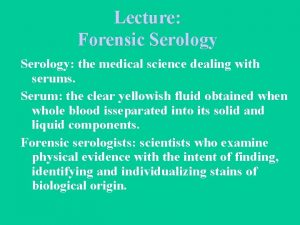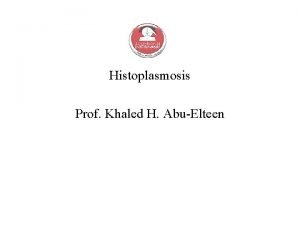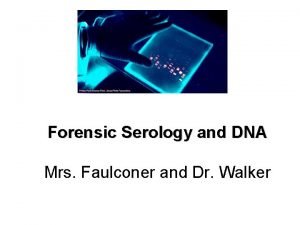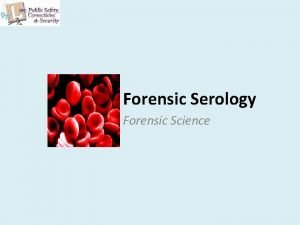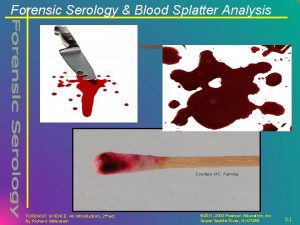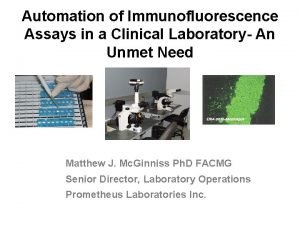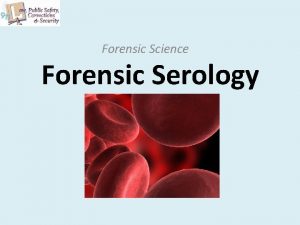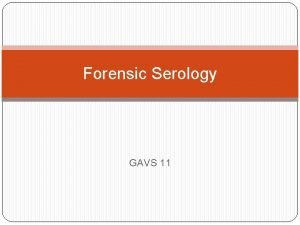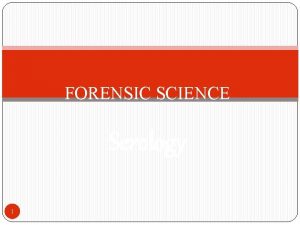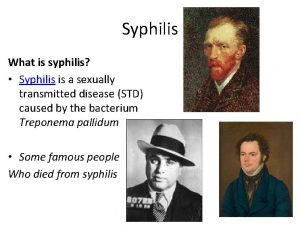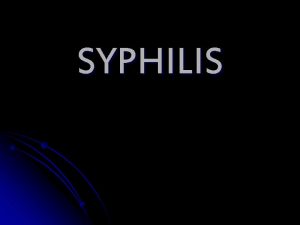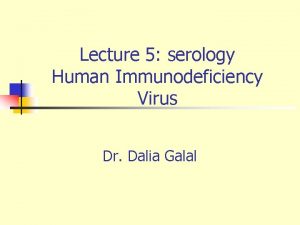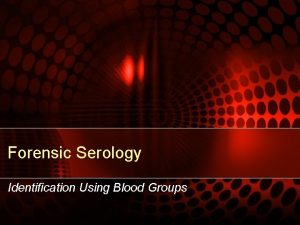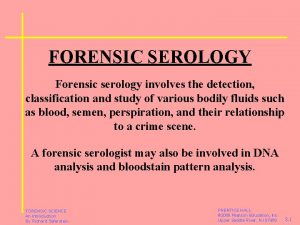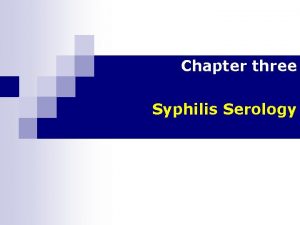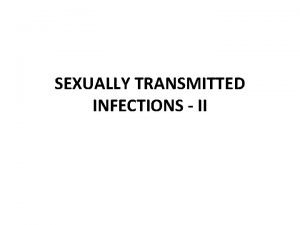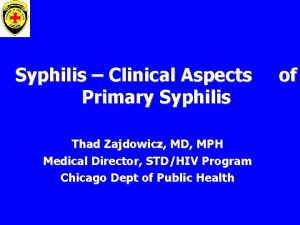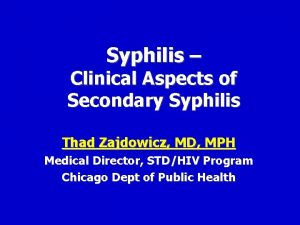Lecture 8 Serology Syphilis Dr Dalia Galal Syphilis



















- Slides: 19

Lecture 8 Serology Syphilis Dr. Dalia Galal

Syphilis A. Introduction 1. The most commonly acquired spirochete disease 2. Syphilis is a complex sexually transmitted disease B. Characteristic of the organism 1. Causative agent is Treponema pallidum, member of the family Spirochaetaceae. 2. No natural reservoir in the environment, requires living host. 3. Organism cannot be cultured from clinical specimens 4. Morphology a. Long, spiral shaped and motile due to per-iplasmic flagella. b. Variable length.

Morphology • Spiral shaped and motile due to periplasmic flagella. • Variable length. Scanning Electron Micrograph of T. pallidum

Mode of Transmission 1. Organism is very fragile, destroyed rapidly by heat, cold and drying. 2. Sexual transmission most common, occurs when abraded skin or mucous membranes come in contact with open lesion. 3. Can be transmitted to fetus. 4. Rare transmission from needle stick and blood transfusion.

Stages of the Disease 1. Primary Stage a. Organism enters directly through skin or through mucosal tissue. b. Carried by blood throughout the body. c. Organisms remaining at the site begin to multiply. d. After variable incubation period of 10 days to several months, a primary lesion (chancre) forms at the entrance site. e. Chancre begins as a small, usually singular nodule; as it enlarges, the overlying epithelial tissues begins to necrose, resulting in a relatively painless ulcer.

f. Unlike other bacterial infections, there is no formation of pus unless a secondary bacterial infection sets in. g. Chancre is most frequently seen on the external genitalia, but in women the lesions may form in the vagina or on the cervix. In men it may be inside the urethra, resulting in a serous discharge. h. The lesion heals spontaneously after 1 -5 weeks. i. Swab of chancre smeared on slide, examined under dark-field microscope, spirochetes will be present. j. Thirty percent become serologically positive one week after appearance of chancre, 90% positive after three weeks.

Primary Syphilis - Chancre

Darkfield Microscopy

2. Secondary Stage a. Occurs 6 -8 weeks after initial chancre, becomes systemic, patient highly infectious. b. Characterized by localized or diffuse mucocutaneous lesions, often with generalized lymphadenopathy. c. Primary chancre may still be present. d. Secondary lesions subside in about 2 -6 weeks. e. Serology tests nearly 100% positive.

Secondary Syphilis • Secondary syphilis lesions on back

3. Latent Stage a. Stage of infection in which organisms persist in the body of the infected person without causing symptoms or signs. b. This stage may be further subdivided. 1) Early latent, initial infection occurred within previous 12 months. 2) Late latent, initial infection occurred greater than 12 months. 3) Latent of unknown duration, date of initial infection cannot be established as having occurred in the previous year. c. This stage may last for years. d. One-third of untreated latent stage individuals develop signs of tertiary syphilis. e. After four years it is rarely communicable sexually but can be passed from mother to fetus.

4. Tertiary Stage divided into three manifestations. a. Occurs anywhere from months to years after secondary stage, typically between 10 and 30 years. b. Gummatous syphilis 1) Gummas are localized areas of granulomatous inflammation found on bones, skin and subcutaneous tissue. 2) Contain lymphocytes, plasma cells and perivascular inflammation. c. Cardiovascular syphilis 1) Inflammatory lesions of the cardiovascular system. 2) Usually involve the aorta, symptoms due to destruction of elastic tissue. 3) May result in thickening of valves.

d. Neurosyphilis 1) Most often associated with tertiary stage but can occur any time after primary stage. 2) Acute meningitis. 3) Tabes dorsalis, degeneration of lower spinal cord, general paresis and chronic progressive dementia.

Tertiary Syphilis Buboe of Neck

Tertiary Syphilis

Tertiary Syphilis - Gumma

5. Congenital Syphilis a. Transmitted from mother to fetus b. Fetus affected during second or third trimester. c. Forty percent result in syphilitic still birth-fetal death that occurs after a 20 week gestation and the mother had untreated or inadequately treated syphilis at delivery. d. Live-born infants show no signs during first few weeks. 1) Sixty to 90 % develop clear or hemorrhagic rhinitis. 2) skin eruptions (rash) especially around mouth, palms of hands and soles of feet. 3) Other signs: general lymphadenopathy, hepatosplenomegaly, jaundice, anemia, painful limbs, and bone abnormalities.

Congenital Syphilis

Treatment 1. Drug of choice penicillin, if allergic, doxycycline. 2. Correlation of treatment with test results. a. Treatment at the primary stage, serology tests become non-reactive (treatment is effective) after 6 months. b. Treatment at secondary stage, tests usually nonreactive after 12 -18 months. c. If treatment is not initiated until 10 or more years, the reagin tests probably positive for life.
 Hemastix definition
Hemastix definition Father of forensic serology
Father of forensic serology Serology
Serology Serology test
Serology test Father of forensic serology
Father of forensic serology Define forensic serology
Define forensic serology Cins ve tür arasındaki farkı örneklerle açıklayınız
Cins ve tür arasındaki farkı örneklerle açıklayınız Void blood spatter
Void blood spatter Prometheus celiac serology
Prometheus celiac serology Forensic science blood basics notes
Forensic science blood basics notes Forensic science meaning
Forensic science meaning Forensic science history timeline
Forensic science history timeline Lines of convergence definition forensics
Lines of convergence definition forensics Serology book
Serology book Serology
Serology Forensic serology definition
Forensic serology definition Dr. dalia dental care
Dr. dalia dental care Dalia kasčiūnaitė
Dalia kasčiūnaitė Numireliska dalia
Numireliska dalia Dalia garcía-malison
Dalia garcía-malison
